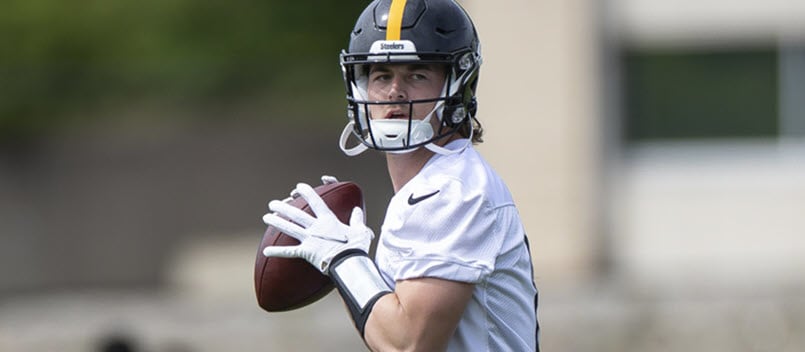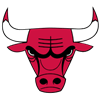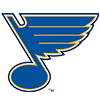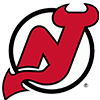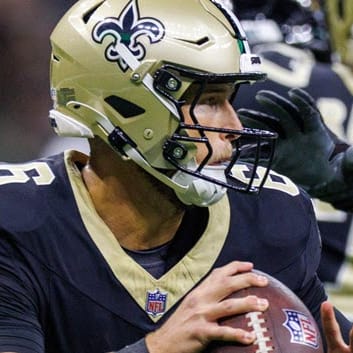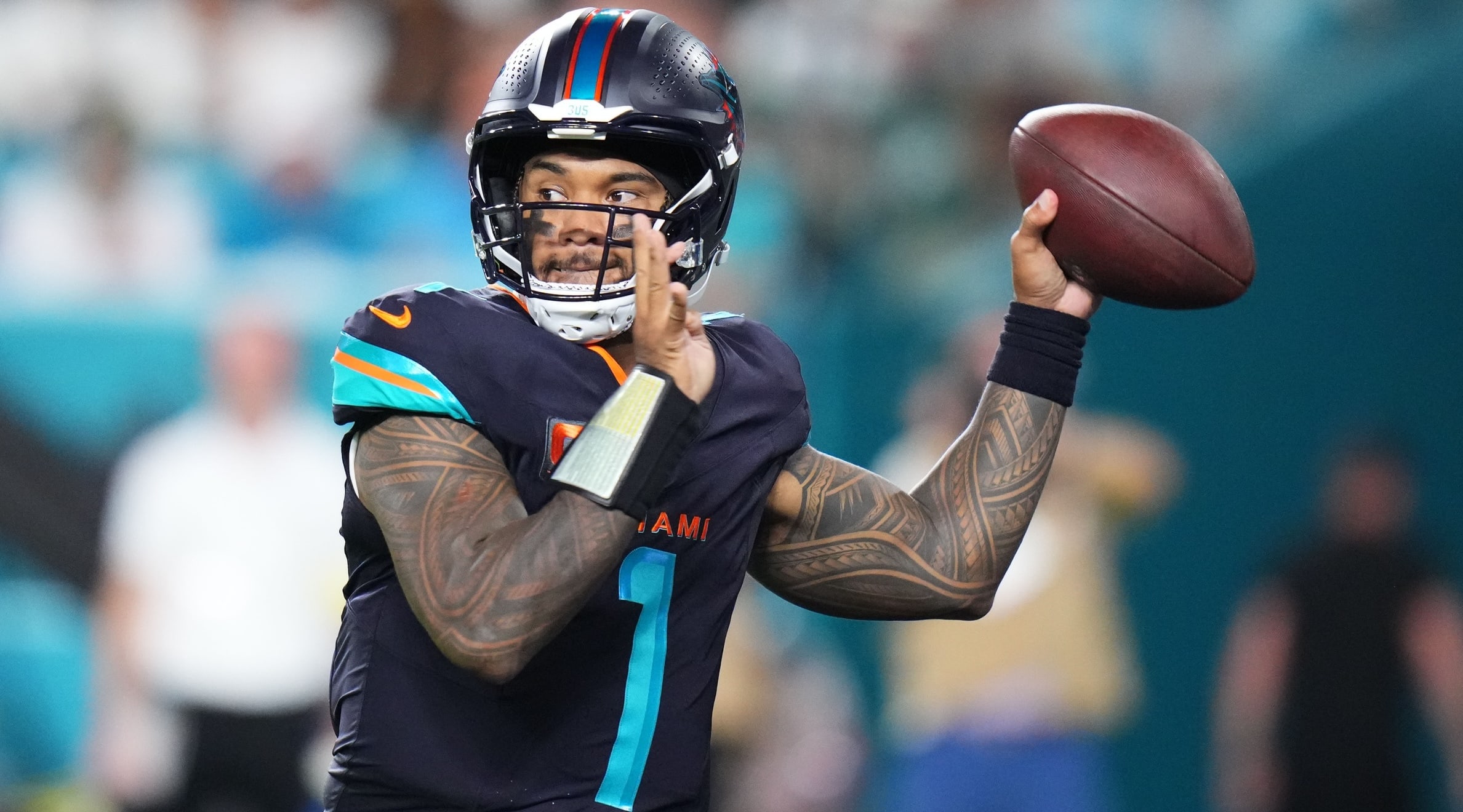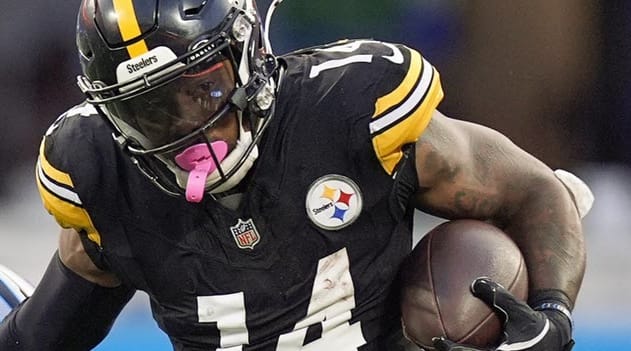Alright, it ran too long but it's finally over. These blurbs run through the ADP of rookies on Underdog best ball drafts, breaking them down from highest pick to lowest. This is the fourth post, looking at rookies No. 25 (Greg Dulcich) through No. 41 (Trestan Ebner). Post three (here) broke down No. 18 (George Pickens) through No. 24 (Romeo Doubs), the second (here) was No. 9 (Rachaad White) through No. 17 (Alec Pierce), and the first installment (here) broke down Breece Hall through No. 8 Christian Watson.
Greg Dulcich, TE, DEN (213.8 ADP)
Fantasy media indulged a wave of Dulcich hype recently because longtime Denver beat writer Mike Klis predicted Dulcich would be Denver's tight end by October. Klis' main reason for this was that Dulcich is faster than Okwuegbunam. Some people care that it was an objectively false statement, others subscribe to the conclusion anyway. Dulcich (4.7-second 40) is much slower than Okwuegunam (4.49) at 15 pounds lighter, and Dulcich's production at UCLA is not clearly distinguished from how Caleb Wilson and Devin Asiasi produced before him.
If Okwuegbunam weren't there I'd get it – Dulcich could be pretty good and he's definitely no bum – but Dulcich's coverage has already gone well past the point of fanfiction. You don't hear of 240-pound tight ends very often, because it's normally a silly suggestion unless the guy is a freak athlete. Dulcich is at best an average athlete, whereas Okwuegbunam is in the conversation for the most athletic tight end in the league. The only tight ends with Dulcich-caliber athleticism who stood out as a fantasy option in recent years are Jordan Reed, who had a totally different skill set as a bruising, slashing runner underneath, and Dalton Schultz, who played a three-down role as the least-defended player in a Dak Prescott offense. Even a fellow finesse tight end like Austin Hooper ran his 4.72 at 11 pounds heavier. Let's be serious, a lot of Dulcich's hype is simply because he does Gardner Minshew stuff and some people still love Chuck Norris memes.
Draft Greg Dulcich if: You think bacon is epic or want Albert Okwuegbunam's backup
Kenny Pickett, QB, PIT (215.3 ADP)
Pickett was a properly bad quarterback in his first four years at Pittsburgh. If not for COVID granting a fifth season he would have been on a practice squad in 2021, and competing for a roster spot this year. I don't think he plays over Mitchell Trubisky unless Trubisky gets benched, and if that happens I expect Pickett to get benched not long after that. His small hands will be a problem particularly in the AFC North, and he had fumbling issues already in college.
Draft Kenny Pickett if: You have a hunch that he might successfully convert to slot receiver before November
Tyler Badie, RB, BAL (214.9 ADP)
Badie was a really good college player at Missouri and demonstrated ability as both a runner and pass catcher there, especially in a 2021 season where he ran for 1,604 yards (6.0 YPC) and 14 touchdowns while catching 54 passes for 330 yards and four touchdowns on 76 targets. At just 5-foot-8, 197 pounds Badie probably won't be more than a rotational back in the NFL, but his 4.49-second 40 might be enough to make his skill set play well on those limited snaps. You can give Badie this much at least: he's better than Mike Davis. It's still difficult to see how he'll contribute much in a Baltimore offense that doesn't throw much to running backs and will primarily try to use J.K. Dobbins when the function is necessary.
Draft Tyler Badie if: You think J.K. Dobbins and Gus Edwards will get hurt again
Tyquan Thornton, WR, NE (215.1 ADP)
Here we go. This is a real prospect. Thornton was widely referred to as a reach in the second round but those were bad takes. Thornton is safely a better prospect out of Baylor than former second-round bust Denzel Mims of the Jets, and that's not a declaration made in hindsight. Thornton showed he had legitimate wide receiver ability his true sophomore year in 2019, when he produced 45 receptions for 782 yards and five touchdowns on 74 targets (60.8 percent catch rate, 10.6 YPT) in an offense that completed 62.4 percent of its passes at 8.0 yards per attempt. The catch rate was 1.6 points below baseline but that's well overruled by the 2.6-yard surplus per target. Thornton turned 19 shortly before that season, and he produced like that while Mims turned 22 the same season. If Thornton can outplay a Baylor baseline primarily set by a 22-year-old Day 2 NFL pick while at age 19, that's a strong positive indicator for his skills, and the 4.27-second 40 is all you need to know about his athleticism.
The problem, of course, is that New England is crowded with receivers. Perhaps the playing time issue never gets sorted out, but understand that Thornton is more talented than any Patriots receiver aside from DeVante Parker. Parker is injury prone, Nelson Agholor should be a backup, Kendrick Bourne is a sixth man type and Jakobi Meyers is due for a target demotion after producing below baseline in 2021. There could be slack for Thronton to capitalize on at some point, and if he gets that chance he's a good bet to rise to the occasion.
Draft Tyquan Thornton if: You build a New England stack or otherwise have considerable exposure to Meyers, Parker or Bourne
Velus Jones, WR, CHI (215.3 ADP)
Jones' collegiate production was not good. He couldn't earn playing time at USC and struggled to stand out at Tennessee until he turned 24.5 – an age at which most viable NFL prospects are already in their third or fourth NFL seasons. Sometimes players don't produce at all in college but succeed in the NFL anyway. The list is not very long, and it doesn't happen as often nowadays, but every once in a while the inexplicable happens and a Tyreek Hill occurs even though he didn't produce at Western Alabama. In cases of poor production it certainly helps to have rare athletic tools with which to project skills growth – it's the only viable explanation for Hill, after all – and Jones has that with a 4.31-second 40 at a stout 204 pounds. Perhaps that's enough for Jones to be a Hill-like exception, but the odds are not good. The skill set is not there in the meantime – he'd be raw by the standards of a 20-year-old player – and Jones isn't even skilled as a runner for screens or gadget plays. This is likely a decoy player on offense and a gunner otherwise.
Draft Velus Jones if: You're willing to take a low floor in exchange for 500-yard upside
Khalil Shakir, WR, BUF (215.5 ADP)
Shakir can play. The question is whether he can play outside or just in the slot. Shakir's extremely short arms are the main reason he fell to the fifth round of the draft, and it may soon prove to be a bad reason. Shakir was extremely productive at Boise State and his 4.43 40 was an excellent time at 6-foot, 196 pounds, so he could prove to be this year's Amon-Ra St. Brown. That's more in the talent sense than the rookie-year production sense – Shakir has no chance of earning as many targets as St. Brown did last year – but Shakir at the very least is a problem for Jamison Crowder and Isaiah McKenzie. Shakir should eventually be able to develop into a Robert Woods-type player
Draft Khalil Shakir if: You think he'll send Jamison Crowder to the bench
Pierre Strong, RB, NE (215.6 ADP)
Strong is interesting not just because he was a fourth-round pick, but also because he's the fastest back in the draft with a 4.39-second 40 at 5-foot-11, 207 pounds. That's skinnier than you'd like to see at running back, but Strong's speed gives him some leeway and if he can earn a pass-catching role his speed could provide a good bang for the target count currency. James White would be the main obstacle on that front, and it's just about impossible to tell what's going on with his hip. Strong is limited with an undisclosed injury himself as of July 28, so he'll need to shake that off to reliably earn the trust of Bill Belichick by Week 1, especially with Rhamondre Stevenson seemingly entrenched as lead pass catcher at running back. Just keep in mind that sixth-round pick Kevin Harris is also hanging around and seems capable as a receiver.
Draft Pierre Strong if: You think James White won't make the team
Keaontay Ingram, RB, ARI (215.8 ADP)
Ingram is one of my favorite fringe prospects in this draft – I love 220-pound running backs who consistently post explosive per-touch production from scrimmage, and Ingram checks those boxes. Ingram had a Trey Sermon-like career (Oklahoma → Ohio State) where he switched from Texas to USC but produced explosively for both of his teams. Unfortunately he also carries the enigma label like Sermon did/does. Ingram was very productive in college, but there was always the sense that he wasn't quite playing up to his talent. Either way, it's worth noting that Ingram has safely superior size-adjusted speed compared to Sermon – Ingram with a 4.59 combine 40 at 221 pounds versus Sermons' 4.61-second pro day 40 at 215.
The problem for Ingram is that the Cardinals gave Darrel Williams a fully-guaranteed salary this year, meaning he'll definitely make the team even though it's just the veteran minimum. This is a problem for Ingram because, while Williams is much worse from scrimmage, Williams is super reliable with passing-down assignments and is likely much more polished than Ingram in blitz pickup. Ingram needs not just a James Conner injury, he also needs the Cardinals to get sick of Williams before they so much as make Ingram active on game day. There's a real risk he ends up on the practice squad, too.
Draft Keaontay Ingram if: You're even higher on him than I am (not advisable)
Kennedy Brooks, RB, PHI (215.8 ADP)
Brooks has a developed rushing skill set but with practice squad-caliber athletic metrics. He also has no history as a pass catcher. But despite his light frame (5-foot-11, 209 pounds) and poor testing (4.59-second 40, 31-inch vertical), Brooks ran like hell at Oklahoma, turning 472 carries into 3,320 yards (7.0 YPC) and 31 touchdowns. Miles Sanders is the clear lead runner in this offense, but don't be shocked if Brooks puts some heat on him or runs well in relief at some point this year. Just understand that the risk is mammoth and the upside is only modest.
Draft Kennedy Brooks if: Miles Sanders gets hurt
Desmond Ridder, QB, ATL (215.8 ADP)
Ridder has the right stuff to be a starting NFL quarterback but we've yet to see whether he has the frame to hold up under pro reps. Ridder is 'too skinny' even at his bulked up combine weight of 211 – he looks like he might have played around 195 or so at Cincinnati – but he has good height (6-foot-3), speed (4.52-second 40) and work habits to grow into a fully-developed quarterback in time. In the meantime he's just the backup to the guy who won the Heisman after throwing for 42 touchdowns and running for 15 touchdowns in 15 games – one who ran his 4.52-second 40 at 222 pounds.
Draft Desmond Ridder if: You're convinced Mariota will miss at least eight games
Danny Gray, WR, SF (215.8 ADP)
Gray is an interesting player for his speed alone (4.33 40) and he was fairly productive at SMU, but it's odd that he wasn't a bit more productive given his age (turned 23 in April) and athleticism at a low level of competition. Gray's efficiency was great, the volume was just a bit lacking. To be fair, he was competing for targets against overaged NFL fringe prospects Reggie Roberson and Grant Calcaterra, so Gray's lack of volume might have been for reasons outside his control. He's unique in the San Francisco wideout group for his speed and deep threat ability, so he should stand out in that regard. The question is whether he can earn more than that over Jauan Jennings, but Jennings is much bigger and probably better than Gray underneath. Gray needs at least one of Deebo Samuel or Brandon Aiyuk to miss time.
Draft Danny Gray if: You need some insurance on substantial Deebo Samuel or/and Brandon Aiyuk exposure
Daniel Bellinger, TE, NYG (215.8 ADP)
Bellinger is interesting as a big, toolsy tight end at 6-foot-5, 253 pounds, boasting 4.63 speed and strong explosiveness testing on that sturdy frame. The Giants are notably light at tight end, too, only otherwise featuring Ricky Seals-Jones and Jordan Akins. Both Seals-Jones and Akins are WR tweener types, so if they play it all it unfortunately might be somewhat at the expense of Bellinger's route running opportunities. Seals-Jones and Akins are both lesser athletes than Bellinger, but because he can play inline and they can't Bellinger might get the more thankless tasks. With that said, the Giants could just scrap the idea of a move tight end altogether, which would clear room for Bellinger to earn a Dawson Knox-like role. The Giants won't throw for as many touchdowns as the Bills, but Bellinger is absolutely in the class of athlete that Knox is.
Draft Daniel Bellinger if: You expect a strong year from Daniel Jones and an invisible one from Seals-Jones/Akins
Cade Otton, TE, TB (215.9 ADP)
Otton (6-foot-5, 247) is an interesting prospect and one whose long-term value looks about as sound as you can reasonably hope of a fourth-round pick tight end, but his route to playing time got a lot narrower with the signing of Kyle Rudolph. Rudolph is a very inline-oriented tight end and his signing might indicate that the Buccaneers don't consider Otton ideal for those functions. If so that would leave Otton more in the category of a finesse tight end, leaving him squared off against Cameron Brate for those types of tasks. Otton can definitely beat Brate for that role, but the Buccaneers might decide either way that they'd rather bring Otton along slowly after an injury-prone career at Washington.
Draft Cade Otton if: The Buccaneers cut Brate
Kyle Philips, WR, TEN (215.9 ADP)
I don't mean to be dismissive, but Philips is a small and quicker-than-fast slot receiver who's playing for the same team that took Dez Fitzpatrick over Amon-Ra St. Brown last year and cut Josh Reynolds in season to watch him produce for the Lions immediately afterward. The Titans have shown bizarre and misguided personnel judgment and Philips is probably another example of that. Can he be an Adam Humphries-like exception? Yes, but not as a rookie and not on this team.
Draft Kyle Philips if: You're shaving points
Isiah Pacheco, RB, KC (215.9 ADP)
Pacheco has one of this draft's best size-adjusted speed grades with a 4.45-second combine 40 at 216 pounds, and he runs with a hotter motor than pretty much anyone. If the Chiefs run game continues to play on the same Easy Mode that made players like Damien Williams and Spencer Ware so productive then Pacheco has what it takes to produce too. Pacheco is a bit wild and might not have the punctuality to earn a role out of training camp, but he's a real threat to make the Chiefs roster and if he does it's unlikely he fails with whatever opportunities he stumbles into. Pacheco does not go down easy and if he has a lane to hit the safety almost immediately has to prepare for long pursuit -- that's an explosive detail in a Patrick Mahomes offense, where the safeties are far off the line of scrimmage and have a business decision to make when they're on their heels and Pacheco is increasing speed in their direction.
Draft Isiah Pacheco if: You want to fade Ronald Jones
Kyren Williams, RB, LAR (215.9 ADP)
Williams is a classic case of a good college back who doesn't have the tools to play much in the NFL. Perhaps all the Rams need from him is 150-200 quality passing down reps and 150 special teams snaps, and if so he can give them that. He probably won't do more than that, though, and he's capable of falling short of those modest playing time marks, too. Williams seems to have a significant amount of skill given that he was an effective workhorse back who moved the ball well as a runner and extremely well as a pass catcher. The issue is that his 4.7-second 40 at 5-foot-9, 194 pounds is prohibitively poor density-adjusted speed. He's among the smallest running backs – he's light even for his height, which is lower than average – yet his 4.7 time is among the worst at the position, normally grouped among big backs and actual fullbacks. As a prospect Williams is basically like if you took Myles Gaskin and made him both smaller and slower.
Draft Kyren Williams if: You need to diversify from your Kyle Philips shares
Trestan Ebner, RB, CHI (216.0 ADP)
Ebner is interesting because he for years has been identified as an unusually skilled pass catcher for a running back, to the point that at times he appeared less a true running back and more like a receiver playing out of position. That's to acknowledge Ebner's limitations as a runner – he won't thrive with every kind of setup, and he probably needs at least some of the space created for him out of the backfield – but he's always explosive when he has field to work with and his pass-catching production is basically unmatched among the 2022 class. Every single positive statement made about James Cook is one that would apply to Ebner in greater magnitude, and Ebner can do other things that Cook straight up can't.
Of course, Chicago won't feel the need to push Ebner on the field like Buffalo might to justify their ill-conceived selection, and even if Ebner beats the odds as a sixth-round pick there might not be much to eat in a Bears offense with limited usage and even less production to distribute. While he's better at it than Cook, Ebner categorically cannot compete for run game reps against David Montgomery or Khalil Herbert. He needs at least one of them to miss time in order to eclipse five carries in any given game, and the pass route reps he gets otherwise might never take off if Justin Fields struggles as a passer.
WITH THAT SAID. If the Bears do give Ebner passing down reps and if Fields doesn't struggle, there could be room for Ebner to do something as a receiver. There's a reasonable case to make that he's actually their third-best wide receiver as it is, even as a running back. Ebner (5-foot-11, 207 pounds) ran a totally sufficient 4.47-second 40 at the combine and pairs that adequate size-adjusted speed with memorable collegiate pass-catching production, boasting 127 receptions for 1,515 yards and 11 touchdowns on 165 targets (77.0 percent catch rate, 9.2 yards per target) over 47 games. Normally I'm driven insane by running backs who can't actually run and have their snaps justified with myths of pass-catching ability (Nyheim Hines, J.D. McKissic, Gio Bernard, Theo Riddick, etc.) but Ebner is an exception to that rule because he can actually play receiver at a level high enough to justify the run skill deficit. It's not some ill-conceived hack -- Ebner is a meaningful threat from scrimmage, and that's the distinction between him and the target plodders that otherwise get praised for their PPR novelty.
Draft Trestan Ebner if: You're high on Justin Fields and want a high-risk, modest-upside long shot pairing in the 18th (USE SPARINGLY)


